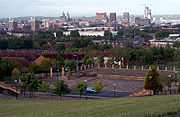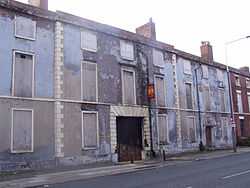Everton, Liverpool
Coordinates: 53°25′08″N 2°57′58″W / 53.4188°N 2.9661°W
Everton is a district in Liverpool, in Merseyside, England and a Liverpool City Council ward. Historically in Lancashire, at the 2001 Census the population was recorded as 7,398.[1]
Toponymy
The name Everton is derived from the Saxon word eofor which meant "wild boar that lived in forests".[2]
Description

Everton is an inner city area located just north of Liverpool city centre, with Vauxhall to the west, Kirkdale to the north and Anfield to the north east. The Liverpool entrance to the Kingsway Tunnel is located near the boundaries of this area. Everton consists of mainly council houses, generally more modern terraced homes and is statistically one of the most deprived areas of the city. Urban clearance during the 1960s and 1970s, followed by the creation of Everton Park, changed the face of the area and some parts have never recovered. "Project Jennifer"[3] is a scheme to breathe new life into rundown parts of Everton centred on Great Homer Street including a revamped 'Greaty' market. However the project has suffered numerous delays and setbacks. The NSPCC Hargreaves Centre (named after locally born benefactor John Hargreaves) was opened in May 2007 on the site of the former indoor market.
History
Everton is an ancient settlement and like Liverpool, was one of the six unnamed berewicks of West Derby. Until the late 18th century Everton was a small rural parish of Walton-on-the-Hill, but the rise in wealth of nearby Liverpool pushed wealthier merchants further afield to live. By the early 19th century however an increase in slums and demand for housing saw Everton began to be built up and in 1835, Everton became part of Liverpool.[4] Much of the land in Everton was once owned by the local Hodson family.
Notable residents
- Thomas de Quincey 19th century author
- Robb Wilton English comedian and actor
- Paul Aloysius Kenna cavalry officer and VC recipient
- Gordon Elliot Australian journalist and talk-show host
It is a hotspot for urban legends, meaning that there are many rumours of dubious credibility throughout history of "monsters" terrorising the area, such as Spring Heeled Jack over a century ago.
Along with neighbouring Vauxhall, Everton traditionally housed the city's Irish, Italian and Polish immigrants. Everton was to be the original site for the building of the Metropolitan Cathedral on St Domingo Road but this was abandoned because of financial constraints. The cathedral was eventually located in the city centre close to the southern edge of Everton.[5]
The book Her Benny by Silas Hocking was mainly set in Everton and dealt with child poverty in the early 1900s.
Landmarks


- Everton water tower, listed building
- St George's Church, Everton
- 59 Everton Road, TA Centre used by the 9th Kings during the South African war and World War I
Everton F.C. connection
The football club Everton F.C. is named after the area, St. Domingo Methodist Chapel was in Everton; St. Domingo FC being the original name of the club. The district is also the location of a building on the club's crest, Everton Lock-Up, known locally as Prince Rupert's Tower. Barker and Dobson, a local sweet manufacturer, introduced "Everton Mints" to honour Everton Football Club.
Ironically, Everton F.C. have never actually played in the area. Their first three homes were located in Anfield including Stanley Park and since 1892 at Goodison Park in the area of Walton. In addition, Everton Cemetery is also not located in Everton, it lies further north-east in the district of Fazakerley.
Schools
- Beacon Church of England Primary
- Campion Catholic High School (demolished 2006)
- Notre Dame Catholic College
- Our Lady Immaculate Catholic Primary
- Whitefield Primary School
References
- ↑ 1.0 1.1 2001 Census: Everton, Office for National Statistics, retrieved 12 January 2009
- ↑ Everton's Origins, Toffee Web, archived from the original on 3 June 2007, retrieved 6 June 2007
- ↑ Project Jennifer, Liverpool City Council, retrieved 16 February 2008
- ↑ Liverpool: Our City, Our Heritage by Freddy O'Connor
- ↑ "History of the Metropolitan Cathedral". Liverpool Metropolitan Cathedral. Retrieved 2009-07-04.
External links
- Liverpool City Council, Ward Profile: Everton
- Liverpool Record Office Online Catalogue for Everton
- Liverpool Street Gallery - Liverpool 3
- Liverpool Street Gallery - Liverpool 5
- Liverpool Street Gallery - Liverpool 6
- Evening images from Everton Brow
| Wikimedia Commons has media related to Everton. |
